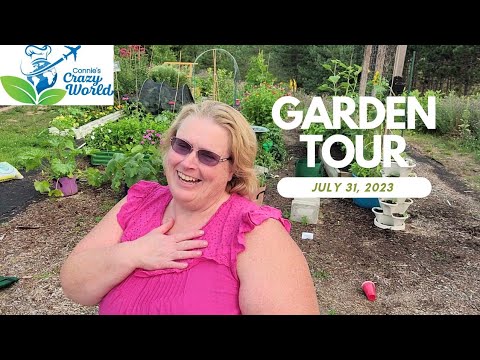Hi there, welcome to my July 31, 2023, garden tour video! Today I’m going to show you around Zone 5B of my native bed and vegetable raised beds. This is a part of my backyard where I grow a variety of plants that are adapted to the local climate and soil conditions, as well as some delicious vegetables for my family and friends. Let’s take a look!
First, let me introduce you to my native bed. This is a low-maintenance area where I have planted some native wildflowers, grasses, and shrubs that attract pollinators and wildlife. Some of the plants you can see here are:
Bee balm (Monarda didyma): This is a cheerful red flower that blooms from June to September. It is a great source of nectar for bees and butterflies, and the leaves have a minty aroma. It grows well in full sun or partial shade, and needs moist, well-draining soil with a neutral pH. Some varieties of bee balm that are hardy in zone 5B are Mitcham Grey, Munstead, and Royal Velvet .
Cup plant (Silphium perfoliatum): This is a tall, sturdy plant that has yellow, daisy-like flowers that bloom from July to September. The leaves form a cup shape that collects water and attracts birds and insects. It prefers full sun and moist, fertile soil. It can be invasive, so it may need to be controlled by cutting back or dividing .
Swamp milkweed (Asclepias incarnata): This is a native plant that serves as a host for monarch butterflies and a nectar source for other pollinators. It has pink or white flowers that grow in clusters on upright stems. It thrives in moist, clay soil and full sun or partial shade .
Next, let me show you my vegetable raised beds. These are wooden and metal boxes that I filled with good quality soil, compost, and amendments. They have several advantages over planting directly in the ground, such as:
Better drainage and aeration for the roots.
Easier weed control and pest prevention.
Higher yields and less space required.
Longer growing season due to warmer soil temperature.
Some of the vegetables I’m growing in these beds are:
Bush beans (Phaseolus vulgaris): These are green pods that contain edible seeds that can be eaten fresh or cooked. They are easy to grow and harvest, and they provide protein, fiber, iron, and folate.
Spaghetti squash (Cucurbita pepo): This is a yellow, oval-shaped squash that has stringy flesh that resembles spaghetti when cooked. It can be used as a low-carb alternative to pasta, and it has vitamin A, C, B6, and potassium.
Watermelon beefsteak tomatoes (Solanum lycopersicum): These are large, juicy tomatoes that have red flesh with yellow streaks. They are sweet and flavorful, and they can be eaten raw or used in salads, sandwiches, sauces, and soups. They have vitamin C, lycopene, and antioxidants.
I hope you enjoyed this garden tour of Zone 5B of my native bed and vegetable raised beds. If you have any questions or comments, please leave them below. And don’t forget to like, share, and subscribe to my channel for more gardening videos. Thanks for watching!
#GardenTour #NativePlants #VegetableGardening #Zone5B #BeeBalm #CupPlant #SwampMilkweed #BushBeans #SpaghettiSquash #WatermelonBeefsteakTomatoes #BackyardGardening #PollinatorGarden #RaisedBeds #LowMaintenanceGarden #EdibleGarden #FlowerGarden #SustainableGardening #OrganicGardening #GardeningTips #GardeningChannel #GardeningFun #GardeningLove #GardeningInspiration #GardeningCommunity #GardeningForLife

